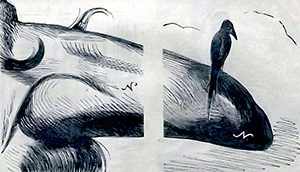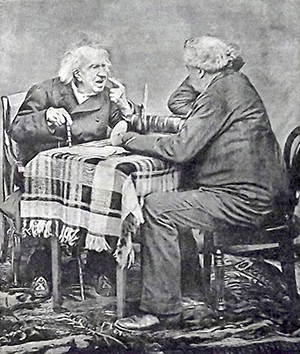[September 2, 2012
“Confound the Line” – Photo-Graphics of the New School of Wood Engraving (Exhibition)
“With the new school nothing is theoretically impossible, and no means are illegitimate.” (Frederick Juengling, 1880)
Wood engraving, actually a product of early English Romanticism, experienced its breakthrough with the rise of the illustrated press. Its phenomenal success owed to its hybridity, for it combined the fine mechanical quality of copper engraving with the advantages of the quick and automatable relief printing of xylography. Its use in mass publications soon led to the development of mechanical engraving methods based on the division of labour; photographs were also frequently used to create the masters. Uniformity and complexity, simplicity and subtlety were very close to each other in wood engraving. However, such ambivalences, which additionally bore the characteristics of mass production, ran contrary to dawning modernism. The actual paradox in the history of wood engraving lies in the fact that its net-like half-tone values, constituting its special aesthetic quality, served as a model for the invention of the dot-scanning method, with which the half-tone method was to replace this manual technique as a reproduction medium around the turn of the century.
Timothy Cole, The Gillie Boy (after James E. Kelly), Scribner´s Monthly Magazine, 1877
Timothy Cole, The Gillie Boy (after James E. Kelly), Scribner´s Monthly Magazine, 1877 (Detail)
Frederick Juengling, A tile, in: The Tile Club at Work, Scibner´s Monthly Magazine, 1879
With the triumph of expressionistic graphics at the beginning of the 20th century, a group of prominent North American photo xylographers, who in the 1870s had caused a sensation with their reproduction-graphical surface verism, fell into oblivion. With the so-called Kelly engravings, which were published in the cultural magazine Scribner´s Monthly in 1877, the young engravers of the emrging New School radically broke with the linear codes of the reproduction-graphical orthodoxy. The attacks of the old xylographic master William James Linton against the, in his opinion, totally expressionless and unartistic new reproduction methods triggered a much-noticed and enduring debate in the American press. This debate, which inspired the graphic historian William Ivins in the 1940s to his seminal work “Prints and Visual Communication”, can be regarded as the starting point of modern communication and media theory.
William James Linton, The Cornfield. (after John Constable), 1860 (Detail)
Timothy Cole, The Cornfield. (after John Constable), 1902 (Detail)
Emblem of the Socitey of American Wood Engravers (SAWE), 1887
As opposed to their European colleagues, the photo xylographers of the New School succeeded in establishing wood engraving as a self-confident, artistic medium. Long before Pop Art, their works combined the prestige of artistic production with the indifference of photographic reproduction. Their signed handmade prints on Japan paper were marketed by leading galleries of the time and shown in museums and world fairs. Proponents of the New School, such as the legendary, short-lived Frederick Juengling from Leipzig, the Düsseldorfer Gustav Kruell, the Alsatian Henry Wolf, and Timothy Cole from London, were stars regarded as equals alongside their befriended, Impressionist painter colleagues.
In the exhibition with approximately thirty exhibits from the William James Linton Archive of the Melton Prior Institute, Düsseldorf, one can find, in addition to examples of photo-xylographic edition prints, a series of hand-signed test prints and proof copies as well as signed prints from printing plates obliterated by geometric grid structures. The hand-signed woodblocks, of which many examples are on display, were also attributed an autonomous, aesthetic value.
Timothy Cole, The Circumcision (after Andrea Mantegna), 1892 (Boxwood, signed on the backside)
Timothy Cole, The Circumcision (after Andrea Mantegna), 1892 (sigend Japanproof)
Timothy Cole, Portait of Whistler´s Mother (after J. M.Whistler), 1881
Timothy Cole, Portait of Whistler´s Mother (after J. M.Whistler), 1881 (Detail)
Henry Wolf: Portrait of Whistler´s Mother (nach J.M. Whistler), 1905 (Detail)
Henry Wolf: Portrait of Whistler´s Mother (nach J.M. Whistler), 1905 (Proof print from the destroyed plate, signed)
Henry Wolf, Henry Mills Alden. 1916 (Proof)
Henry Wolf, Henry Mills Alden. 1916 (Proof) (Detail)
Henry Wolf, Portrait of Richard Canfield. “His Reverence.” (after J.M. Whistler), 1906 (Detail)
Henry Wolf, Portrait of Richard Canfield. “His Reverence.” (after J.M. Whistler), 1906 (Detail)
Henry Wolf, Portrait of Richard Canfield. “His Reverence.” (after J.M. Whistler), 1906
Henry Wolf, Portrait of Henry Irving, 1900 (Proofs on Japanpaper)
Henry Wolf, Portrait of Henry Irving, 1900 (Proof) (Detail)
Henry Wolf, Portrait of Henry Irving. 1900 (Proof from the destroyed engraving, signed)
A contemporary work is also on view, the 10 x 10 cm miniature painting «..the wood for the trees» by the English artist Simon Lewis, created between 1998 and 2000 in Denmark. The radical hyper-pointillistic conception expressed in the miniature picture greatly inspired the set-up of the collection of wood engravings of the Melton Prior Institute.
Simon Lewis: «…the wood for the trees», 1998 – 2000, Oil and Gesso on Boxwood
The exhibition is being curated by Alexander Roob. A catalogue will be published in conjunction with the show in the series “Der un/gewisse Blick” edited by Thomas Ketelsen. The catalogue “Chinesische Methode. Die Fotografik der New School of Wood Engraving” can be ordered by the Museum Shop.
Wallraf – Richartz Museum, Cologne, 14 September 2012 – 6 January 2013 (Gallery for Prints and Drawings)
——————————————————————————-
Link list of source material
> The Linton Archive. On the Formations of Political Art and Wood Engraving / Zur Entwicklungsgeschichte von politischer Kunst und Xylographie
> W.J. Linton: Thirty Pictures by deceased British Artists, London 1860
> John Jackson, W.A. Chatto: A Treatise on Wood Engraving (with a new chapter on the artists of the present day). London 1838 / 1861
> John Ruskin: Ariadne Florentina – Six Lectures on Wood and Metal Engraving with an Appendix, 1872.
> Div.: Scribner’s Monthly Magazine Vol. 16, New York 1878
> Div.:The Atlantic Monthly Vol. 43, Boston 1879
> W.J. Linton : Some practical Hints on Wood Engraving, Boston 1879
> Div.: A Symposium of Wood Engravers. in: Harper’s New Monthly Magazine, February 1880
> Proofs from Scribner’s Monthly and St. Nicholas: A Portfolio of Proof Impressions Selected from Scribner’s Monthly and St. Nicholas., New York 1880
> W.J. Linton: The History of Wood Engraving in America, Boston, 1882
> George Edward Woodberry: A History of Wood – Engraving. New York 1883
> W.J. Linton: Wood- Engraving. A Manual of Instruction, New Haven, 1884
> Carl von Lützow ed.: Der Holzschnitt der Gegenwart in Europa und Nord-Amerika. Vienna 1887
> William M. Laffan ed.:Engravings on Wood by Members of the Society of American Wood-Engravers.
New York 1887
> W.J. Linton: The Masters of Wood Engraving, Hamden / London, 1889
> William Abercrombie: A Scrapbook on Wood Engraving.Ashton upon Mersey, 1880 – 1899
> Frank Weitenkampf: American Graphic Art, New York 1912
> Henry Wolf: Album, New York, ca. 1880 – 1916
> A.V.S. Anthony, Timothy Cole and Elbridge Kingsley: Wood-Engraving. Three Essays by Three Engravers.
New York 1916
> Paul Westheim: Das Holzschnittbuch. Potsdam 1921
> Alphaeus Cole and Margaret Ward Cole: Timothy Cole. Wood-Engraver.Boston / New York 1935
> William M. Ivins: How Prints Look. Photographs with A Commentary. New York 1943
> William M. Ivins: Prints and Visual Communication. Chicago 1953
> Estelle Jussim: Visual Communication and the Graphic Arts: Photographic Technologies in the Nineteenth Century. New York – London 1974 / 1982
> Gerry Beegan: The Mass Image: A Social History of Photomechanical Reproduction in Victorian London.
Houndsmills / New York 2008
> William H. Brandt: Interpretive Wood-Engraving: The Story of the Society of American Wood-Engravers.
New Castle, Delaware. 2000


























